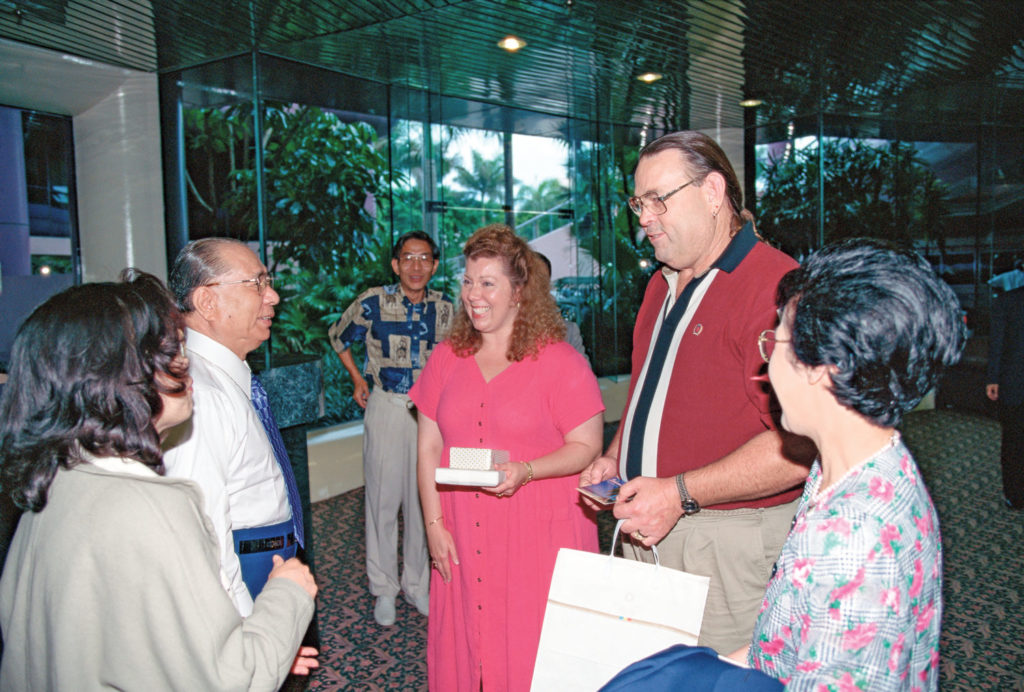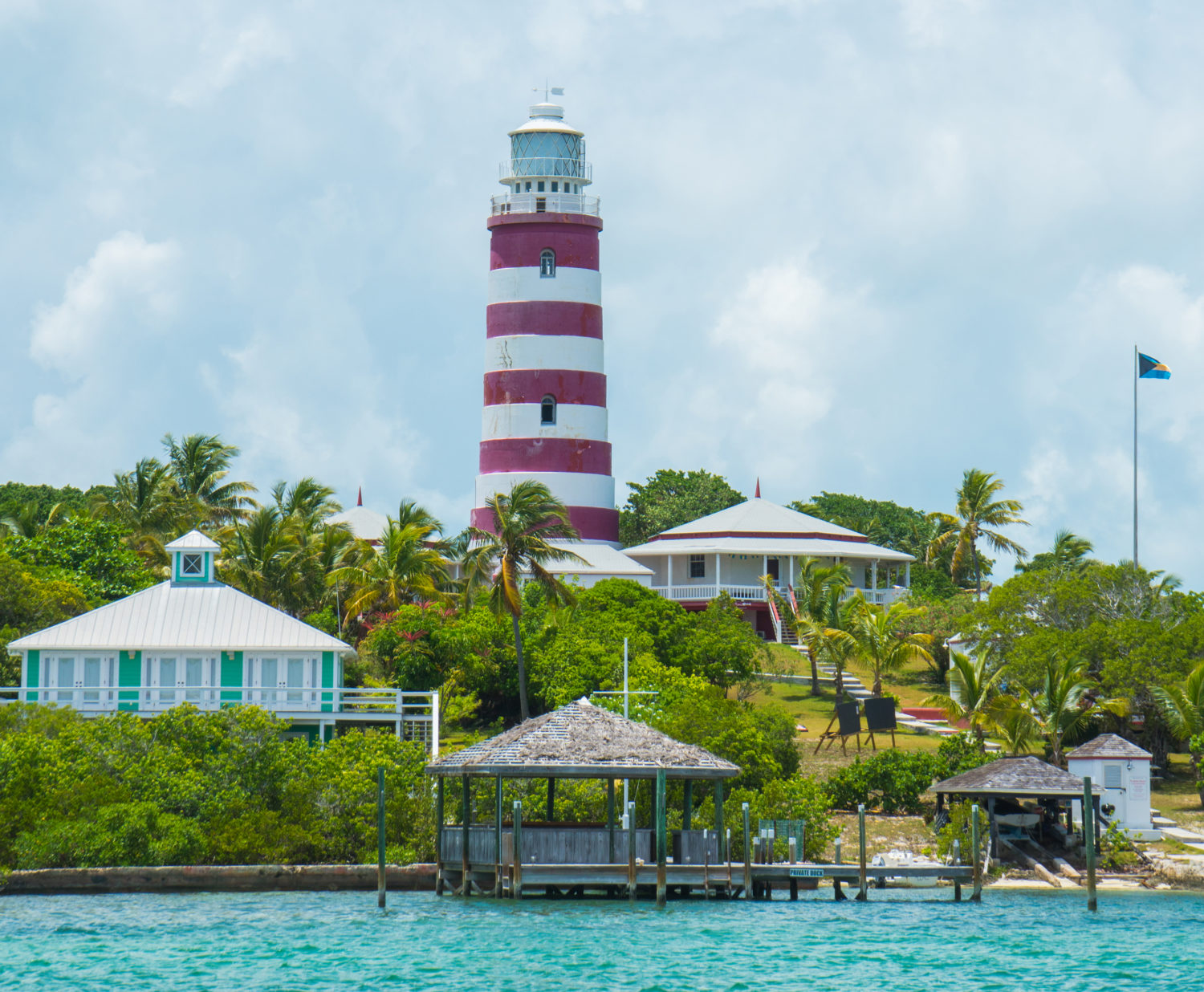Linda Giovino-Albury
Marsh Harbour, Bahamas
Living Buddhism: Thank you, Linda, for sharing your experience with us. We understand you and the other members in the Bahamas were affected by Hurricane Dorian. We’re happy to hear you are all safe and well!
Linda Giovino-Albury: It’s all thanks to the Gohonzon and this wonderful practice. Also, having lived in a remote area, I have so much appreciation for the SGI-USA publications (World Tribune and Living Buddhism). They’ve been my lifeline to SGI President Ikeda’s encouragement. Thank you for this opportunity to share my experience in faith.
What was your upbringing like?
Linda: My father was abusive, and his impact on the family went deep. I often stayed late at school and worked long hours to avoid going home. And at home, I spoke only when spoken to and tried to do everything right. There was so much fear, and I was shamed for using my voice.
It was difficult to find gratitude in my life. My father said things to us that seemed irreversible. Because of this, words became so meaningful to me. I saw how they could cause a lifetime of joy or harm.
Thanks to my Buddhist practice and Sensei’s encouragement, I’ve developed a strong inner core that is no longer shaken by my circumstances.
Thank you for speaking so openly about your upbringing. How did you encounter Buddhism?
Linda: I moved to Florida to pursue musical theater. In June 1987, a woman came into a restaurant where I worked as a server, and her regal bearing caught my attention. When she asked me what I did, I shared with her that I was unsure about my life. She then wrote Nam-myoho-renge-kyo on a napkin and asked me if I had heard of it.
Somehow, I just knew with my life that Nam-myoho-renge-kyo was powerful, especially because I believed in the power of voice. I immediately agreed to go to a meeting.
Everything I learned at my first SGI meeting made sense, and afterward, I started attending the morning chanting sessions at a member’s home. I was moved by how beautiful the Gohonzon was, and I loved chanting. Shortly after, I received the Gohonzon.

What changed after that?
Linda: Before practicing, life felt so heavy when I woke up every morning, and I couldn’t really understand why. Each Nam-myoho-renge-kyo that I chanted felt like a profound cause to move my life forward.
It became clear to me that my inner state of life directly impacted my daily life and environment. When I chanted, my day went better; even the aerobics classes I taught became more synchronized. And when I started participating in SGI activities and supported other young women in faith, my life advanced much faster. On the flip side, when my practice stagnated, my life grew muddy again.
So, whatever my seniors in faith shared, I challenged myself to apply their guidance to my life. It was a battle to win over myself and chant just one more Nam-myoho-renge-kyo. Eventually, all these causes opened up the most unexpected path to the Bahamas.
How did you end up in the Caribbean?
Linda: In 1991, while supporting the local SGI community center in Florida, I met my future husband, Glenn, who was visiting from Abaco Islands, Bahamas. Three years later, I decided to move there.
The island was primarily a forest with only one stoplight. On top of that, no members were there. I knew that living there would be a challenge, but I was inspired by Sensei’s stand-alone spirit:
“It starts with me! It starts from now!”— as long as we have this courageous, self-motivated spirit of a lion king in faith, we can definitely triumph over all adversity.
(Learning From Nichiren’s Writings: The Teachings for Victory, vol. 2, p. 89)
Sensei’s spirit is always: If I don’t do it, who will? So I thought to myself: If I don’t advance kosen-rufu in the Bahamas, who will? I decided to stand up alongside Sensei and infuse the island with the Mystic Law.
What was life like there?
Linda: Despite my years of practice, without the support of other SGI members and meetings, my practice suffered, and as a result, I did, too. I was fortunate to still be in touch with members in Florida, but the SGI-USA’s publications were truly my only support.
When I remembered our pioneer members’ struggles to establish both their lives in a foreign country and a foundation for kosen-rufu in America, it gave me strength to persevere.
I held discussion meetings by myself as a cause for the future and flew to Florida to participate in activities as much as possible. And each time I went, I brought envelopes with my contact info so that Sensei would learn that there was an SGI member in the Bahamas.
What was the turning point?
Linda: In June 1996, the SGI-USA Florida Nature and Culture Center in Weston, Florida, was set to open during President Ikeda’s visit there. Toward this historic opening, I chanted to be in rhythm with my mentor and his vow for peace.
The next day, I had the honor of supporting the opening session as a member of the Byakuren Group, the behind-the-scenes training group for young women. That evening, I received a call from Sensei’s office. He had changed his travel plans to visit the Bahamas!
What was your encounter with President Ikeda like?
Linda: We traveled to Nassau and waited for Sensei and Mrs. Ikeda. When they arrived, Sensei walked as straight as an arrow toward me. With so much focus and intent, he shook my hands and said, “We’re friends, not just today, but throughout eternity.” I felt him pouring his entire life into our one encounter.
Then, Mrs. Ikeda said: “Were you supporting as Byakuren for the movement in Florida? I saw you.” I realized both Sensei and Mrs. Ikeda were watching everything, and that they understood everything I was going through trying to pioneer kosen-rufu on an island.
It was a brief encounter, but I was so happy to know that he had heard my voice from the Bahamas. And for the next 10 years, I received a gift from Sensei every time I visited the center in Florida.
How amazing! How did kosen-rufu develop from there?
Linda: Life in the Bahamas was still a battle of perseverance. I determined to start fresh by challenging a chanting campaign to change my own lack of courage and stand up for myself.
The number of SGI members in the Bahamas gradually increased. We were on different islands, but we communicated through email and chanted at the same time. This moved everything forward.
Over the years, I also supported my husband, who is a recovering addict and a bilateral amputee, and 16 dogs that I am absolutely passionate about. And because the island was still developing, electricity and water would cut off unexpectedly, or we would be charged hundreds of dollars in bills. At times, I felt there was a brick wall everywhere I turned. I had no choice but to chant with a fighting spirit in the tropical heat and use every obstacle to forge my faith.
In hindsight, I can see that my mission now is to show how to live with an undefeatable spirit, and I am sure that this is precisely the reason I have taken on the challenge of pioneering kosen-rufu in the Bahamas.
We understand you faced the devastation of Hurricane Dorian last summer. How did you surmount this obstacle?
Linda: Everything around us was obliterated. But, not a single drop of rain came into our home, and everyone, including my dogs, were safe. It wasn’t over, though. People were out looting, and a fire broke out near our home. I chanted for hours in the pitch-black darkness for our safety. It was a glimpse of Nichiren Daishonin’s struggle on Sado Island! I kept recalling “Drum at the Gate of Thunder,” where Nichiren writes:
Those who make offerings to the Lotus Sutra will receive the same benefit as they would by making offerings to all the Buddhas and bodhisattvas in the ten directions, because all the Buddhas of the ten directions originate from the single character myo. Suppose a lion has a hundred cubs. When the lion king sees its cubs attacked by other beasts or birds of prey, he roars; the hundred cubs will then feel emboldened, and the heads of those other beasts and birds of prey will be split into seven pieces. The Lotus Sutra is like the lion king, who rules over all other animals.
(The Writings of Nichiren Daishonin, vol. 1, p. 949)
A woman who embraces the lion king of the Lotus Sutra never fears any of the beasts of hell or of the realms of hungry spirits and animals.
After chanting, I read aloud into the night, “Still I am not discouraged” (“The Essentials for Attaining Buddhahood,” WND-1, 748). I vowed to never have any doubts and to make wherever I am the Buddha land, together with Sensei.
The next morning, a U.S. Coast Guard helicopter hovered over my roof, and we were taken to safety. We’re now in Florida, and I’m grateful that we made it out safely. I can only say that it was the power of our prayer to the Gohonzon that we were safe.
How are things today?
Linda: There’s still a mountain of obstacles. Rebuilding will take quite some time. On the bright side, a news channel covered my story and
a woman gifted me her old Jeep! Somehow, we’ve been able to find the right help at each step.
Most of all, I’m now able to attend SGI meetings and chant with other members. I recently introduced two people to the practice, and I’m chanting that they can receive the Gohonzon soon! I’m not giving up, and I’m chanting every day to fulfill my mission.
What are your determinations moving forward?
Linda: Last June, I was appointed as a unit leader for Bahamas District. Most of our activities are conducted on Nassau, a neighboring island in the Bahamas, so I flew there to be appointed! Since I am currently the only member practicing in Abaco, my main goal is to share this Buddhism with others.
To be alive at this time, together with Sensei, is in itself the greatest fortune. In this vast universe, it’s truly phenomenal that we get to share our life with such an outstanding individual. Sensei could’ve chosen a comfortable life, but he decided to carry on his mentor’s mission. If it weren’t for his selfless efforts, I would have never encountered the Gohonzon or this practice, and my life would’ve been completely different.
My determination is to carry on Sensei’s spirit into the future. I want to continue moving forward—to continue exerting myself in the frontlines of kosen-rufu and to continue sharing this Buddhism. To me, hope is action.
Thank you, Linda. Your strength is absolutely inspiring. In our efforts to introduce 6,000 youth this year, is there anything you’d like to share with the youth?
Linda: If we stick with Sensei and the SGI, continue to chant and encourage one another, our lives will absolutely be on the greatest path. At times, we might have a certain path in mind or it might seem like things aren’t working out, but dedicating our lives to the Mystic Law opens up avenues we never even dreamed of.
Whatever you’re going through, never give up and continue chanting Nam-myoho-renge-kyo, and you’ll move toward your dreams. My hope is that every youth can experience this truth for themselves.
You are reading {{ meterCount }} of {{ meterMax }} free premium articles

